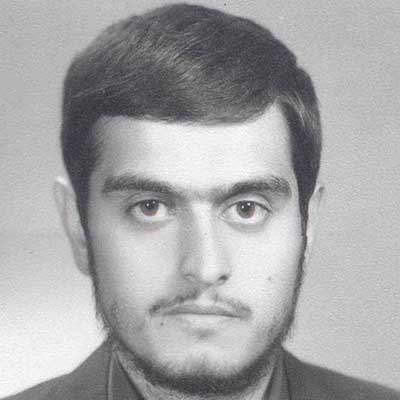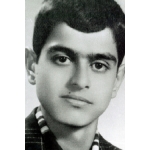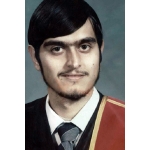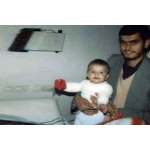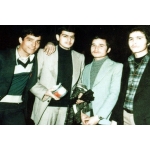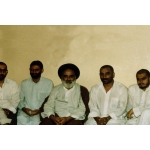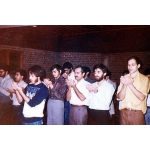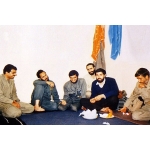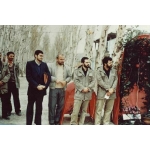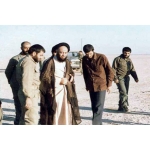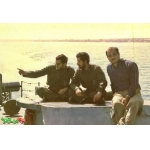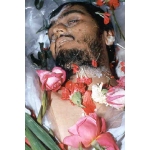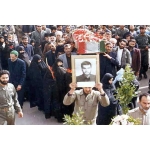Aqasi-Zadeh Sher-Baaf, Hasan
Masoumeh Abedini
318 بازدید
Hasan Aqasi-Zadeh Sher-Baaf (1959-1987) served as the Deputy of Technical and Engineering Affairs at the Khatam al-Anbiya Construction Headquarters during the Sacred Defense. He was born in Mashhad in the autumn of 1959. He was a diligent student throughout his education. Since adolescence, Aqasi-Zadeh was committed to fulfilling his religious obligations, and thus participated in religious gatherings, and studied the works of Ayatollah Motahhari and the treatise of Imam Khomeini (ra). When he was in high school, he was repeatedly threatened and beaten by SAVAK for distributing tapes and leaflets containing Imam Khomeini’s remarks and messages.
As the people's opposition against the Pahlavi regime peaked and after obtaining his diploma, Aqasi-Zadeh had to either pursue higher education abroad or continue his revolutionary activities. However, after consulting with the representative of Imam Khomeini in Qom, his father, and a group of teachers, he decided to pursue higher education in Canada.
When Imam Khomeini (ra) left Iraq for Paris, Aqasi-Zadeh was studying structural engineering at the University of Toronto in Canada. Along with several other Iranian students in Canada, he traveled to Paris and assumed the duty of guarding Imam Khomeini's residence for fourteen days. In addition, he also served as an interpreter for journalists.
After coming to know the academic background of Aqasi-Zadeh and his friends, Imam Khomeini (ra) told them, "We will need you in the near future; finish your studies quickly so that you can replace those affiliated with the regime in various organizations". Therefore, he returned to Canada.
Aqasi-Zadeh obtained an M.A. in bridge engineering, choosing "Missile Base" as the topic of his thesis, given the necessity of dealing with such issues in the country. He successfully defended his thesis, and soon after, the Guardian newspaper interviewed him. As his interview was published in the newspaper, Aqasi-Zadeh received a job offer in Canada with a sufficient salary. But he rejected the offer saying, "I must return to Iran and serve my nation; I owe it to my country".
When Aqasi-Zadeh was in Canada, the Muslim Student Followers of the Imam's Line seized the US Embassy in Tehran demanding the extradition of the Shah back to the country. The embassy takeover led to extensive negative media campaigns launched against Iran by the foreign media. In an interview with a Canadian newspaper, Aqasi-Zadeh elucidated and explained the students' objectives. This interview was highly effective in conveying the students' goals and countering the negative Western propaganda.
In 1982, Aqasi-Zadeh returned to Iran and settled down. Initially, he joined the Jihad of Construction and, together with his wife, stayed in Khaf—a city in South Khorasan—for six months to serve the locals. He then served in the engineering division of the Islamic Revolutionary Guard Corps (IRGC).
Due to his competence and great ambition, he demonstrated his capabilities in various missions. When the Ministry of the IRGC was tasked with establishing the Serat-al-Mostaqim and Khatam al-Anbiya Headquarters to effectively utilize the ministries' resources for the war, Aqasi-Zadeh became the Deputy for Technical and Engineering Affairs at the Khatam al-Anbiya Headquarters.
Aqasi-Zadeh was directly involved in the construction and supervision of many projects such as the Fatemeh Zahra (as) and Imam Reza (as) Hospitals, missile sites, military bases, and major projects that significantly impacted the war's outcome. He also played a key role in constructing dams, water diversion channels, defensive embankments, support roads, and the installation and repair of fixed and floating bridges.
During Operation Valfajr 8, when Iraq launched a massive aerial attack on Fav and Arvand Rud, bombing all the bridges that connected the Iranian forces-from the mouth of the Persian Gulf to Abadan's Station 7, Aqasi-Zadeh was relentlessly working hard to help his country. He would move the foam units (acoustic panels) of floating bridges like a simple worker to expedite the bridge installations so commanders could send reinforcements to the frontlines.
In Operation Karbala 5, when some of the Iranian forces were surrounded by the Iraqi, he worked overtime to construct a bridge to help the troops cross the river. He worked tirelessly such that he suddenly fell asleep on the bridge from exhaustion and fell into the river His comrades saved him from drowning or being captured by Iraqi forces.
Aqasi-Zadeh participated in various operations including Ramadan, Muharram, Kheibar, Valfajr 1 to 9, Badr, Karbala 1 through 10, Fath, and Nasr. He was wounded five times and suffered a severe back injury, yet never underwent complete treatment.
On July 24, 1986, as he was preparing for the Hajj pilgrimage, Aqasi-Zadeh wrote a lengthy will. After praising and thanking God, saluting the Prophet (pbuh) and the Infallible Imams (as), and appreciating Imam Khomeini's leadership, he thanked God for the blessing of being with the combatants, repenting for his sins and disobedience, acknowledged the significance of Hajj, and expressed gratitude to his parents. In a part of his will, he wrote about his wife: "The best memory I have of her is sharing the loneliness and hardships I have endured; and, of course, we are proud that all these sufferings were for the sake of Islam and the war. After my death, anyone who loves me should treat her with kindness".
On October 20, 1987, during operation Nasr 8, Aqasi-Zadeh entered the operational area in Sulaymaniyah, Iraq at night. While he was moving with his vehicle's lights off, an artillery shell struck the slopes overlooking the road. As a result, large rocks fell onto the road causing his vehicle to veer off towards a cliff, causing the martyrdom of Aqasi-Zadeh.[1]
Hasan Aqasi-Zadeh had three children namely Hojjat, Zeynab, and Zahra. His body was buried in the Azadi Courtyard of the Holy Shrine of Imam Reza (as) in Mashhad.
[1] Reference: A Summary of an article published in the Sacred Defense Encyclopedia, Vol. 1, Tehran, The Center of Encyclopedia of the Sacred Defense Research Institute, 2011, Pp. 186-188.


